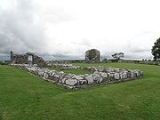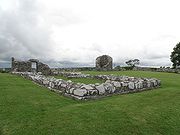
Nendrum Monastery
Encyclopedia

Christianity
Christianity is a monotheistic religion based on the life and teachings of Jesus as presented in canonical gospels and other New Testament writings...
monastery
Monastery
Monastery denotes the building, or complex of buildings, that houses a room reserved for prayer as well as the domestic quarters and workplace of monastics, whether monks or nuns, and whether living in community or alone .Monasteries may vary greatly in size – a small dwelling accommodating only...
on Mahee Island in Strangford Lough
Strangford Lough
Strangford Lough, sometimes Strangford Loch, is a large sea loch or inlet in County Down, Northern Ireland. It is separated from the Irish Sea by the Ards Peninsula. The name Strangford is derived ; describing the fast-flowing narrows at its mouth...
, County Down
County Down
-Cities:*Belfast *Newry -Large towns:*Dundonald*Newtownards*Bangor-Medium towns:...
, Northern Ireland
Northern Ireland
Northern Ireland is one of the four countries of the United Kingdom. Situated in the north-east of the island of Ireland, it shares a border with the Republic of Ireland to the south and west...
. Medieval records say it was founded in the 5th century, but this is uncertain. The monastery came to an end at some time between 974 and 1178, but its church served a parish until the site was abandoned in the 15th century. Some remains of the monastery can still be seen.
History
The island monastery of Nendrum was traditionally founded in the 5th century by Machaoi, after whom Mahee Island is named, although a later date for the foundation has been suggested. However, dendrochronologyDendrochronology
Dendrochronology or tree-ring dating is the scientific method of dating based on the analysis of patterns of tree-rings. Dendrochronology can date the time at which tree rings were formed, in many types of wood, to the exact calendar year...
has dated a tide mill
Tide mill
A tide mill is a water mill driven by tidal rise and fall. A dam with a sluice is created across a suitable tidal inlet, or a section of river estuary is made into a reservoir. As the tide comes in, it enters the mill pond through a one way gate, and this gate closes automatically when the tide...
on the island to the year 619, making this the oldest excavated tide mill anywhere in the world. The monastic site included orchard
Orchard
An orchard is an intentional planting of trees or shrubs that is maintained for food production. Orchards comprise fruit or nut-producing trees which are grown for commercial production. Orchards are also sometimes a feature of large gardens, where they serve an aesthetic as well as a productive...
s, garden
Garden
A garden is a planned space, usually outdoors, set aside for the display, cultivation, and enjoyment of plants and other forms of nature. The garden can incorporate both natural and man-made materials. The most common form today is known as a residential garden, but the term garden has...
s, pasture
Pasture
Pasture is land used for grazing. Pasture lands in the narrow sense are enclosed tracts of farmland, grazed by domesticated livestock, such as horses, cattle, sheep or swine. The vegetation of tended pasture, forage, consists mainly of grasses, with an interspersion of legumes and other forbs...
s, arable fields
Arable land
In geography and agriculture, arable land is land that can be used for growing crops. It includes all land under temporary crops , temporary meadows for mowing or pasture, land under market and kitchen gardens and land temporarily fallow...
, and a guest-house.
In his Ecclesiastical Antiquities of Down, Connor, and Dromore, William Reeves
William Reeves (bishop)
William Reeves was an Irish antiquarian and the Church of Ireland Bishop of Down, Connor and Dromore from 1886 until his death...
notes that several annals record the death of St Mochaoi of Nendrum at a variety of dates between 490 and 497. He considers that Nendrum was early chosen as the seat of a bishop, quoting the Annals of Tigernach
Annals of Tigernach
The Annals of Tigernach is a chronicle probably originating in Clonmacnoise, Ireland. The language is a mixture of Latin and Old and Middle Irish....
and the Annals of Ulster
Annals of Ulster
The Annals of Ulster are annals of medieval Ireland. The entries span the years between AD 431 to AD 1540. The entries up to AD 1489 were compiled in the late 15th century by the scribe Ruaidhrí Ó Luinín, under his patron Cathal Óg Mac Maghnusa on the island of Belle Isle on Lough Erne in the...
, both of which describe Cronan (died c. 640) as "bishop of Nendrum".
There are references to Nendrum in various sources, such as the Annals of the Four Masters
Annals of the Four Masters
The Annals of the Kingdom of Ireland or the Annals of the Four Masters are a chronicle of medieval Irish history...
, between the 7th century and the year 974, when the Four Masters record that "Sedna Ua Demain, Abbot of Nendrum, was consumed in his own house". This is read as meaning that Sedna was burnt, perhaps during a Viking
Viking
The term Viking is customarily used to refer to the Norse explorers, warriors, merchants, and pirates who raided, traded, explored and settled in wide areas of Europe, Asia and the North Atlantic islands from the late 8th to the mid-11th century.These Norsemen used their famed longships to...
raid, and is the last heard of Nendrum in the annals. Reeves says –
The English monks were Benedictine
Benedictine
Benedictine refers to the spirituality and consecrated life in accordance with the Rule of St Benedict, written by Benedict of Nursia in the sixth century for the cenobitic communities he founded in central Italy. The most notable of these is Monte Cassino, the first monastery founded by Benedict...
s and founded a small cell on Mahee Island. However, in 1306 Nendrum was recorded as a parish church, and during the 15th century it was abandoned for a new site at the village of Tullynakill. The location of Nendrum was then lost until it was rediscovered in 1844 by William Reeves, who visited the island searching for the church recorded in 1306 and recognized the remains of a round tower
Irish round tower
Irish round towers , Cloigthithe – literally "bell house") are early medieval stone towers of a type found mainly in Ireland, with three in Scotland and one on the Isle of Man...
.
Archaeology
Since being excavated by H. C. Lawlor between 1922 and 1924, with the resulting finds now kept in the Ulster MuseumUlster Museum
The Ulster Museum, located in the Botanic Gardens in Belfast, has around 8,000 square metres of public display space, featuring material from the collections of fine art and applied art, archaeology, ethnography, treasures from the Spanish Armada, local history, numismatics, industrial...
, the site has been much restored. The rectangular building yielded about 30 slate tablets bearing Celtic designs. These 'trial-pieces' are now in the Ulster Museum along with a bell and a stone with an inscription in runes also from the site. Parts of the site were excavated later, by A. C. Thomas in 1954, by D. Waterman in the 1960s and by N. Brannon in 1979 and 1982. Lawlor's work was the first extensive excavation of such a large ecclesiastical site, and his technique has been criticized by modern standards, but one of the reasons for Nendrum's importance to archaeologists is that it is still the only major site of its kind which has been the subject of published excavation reports.
Features
The principal monastic remains which can now be seen are three concentric cashelRingfort
Ringforts are circular fortified settlements that were mostly built during the Iron Age , although some were built as late as the Early Middle Ages . They are found in Northern Europe, especially in Ireland...
s (enclosures) of dry stone
Dry stone
Dry stone is a building method by which structures are constructed from stones without any mortar to bind them together. Dry stone structures are stable because of their unique construction method, which is characterized by the presence of a load-bearing facade of carefully selected interlocking...
walling, but these were substantially rebuilt by Lawlor in the 1920s. The central cashel has the round tower remains, a ruined church with a sun-dial, and a graveyard. The second cashel contains what is called a 'monastic school' or workshop and other burials.
The sun-dial now seen at one corner of the ruined church was reconstructed from fragments found during the excavation of the site in 1924 and has been dated to about the year 900. One of only a few early medieval sun-dials known to exist, it takes the form of a vertical stone pillar, 190 cm high, 40 cm wide and 15 cm thick, with the dial and gnomon
Gnomon
The gnomon is the part of a sundial that casts the shadow. Gnomon is an ancient Greek word meaning "indicator", "one who discerns," or "that which reveals."It has come to be used for a variety of purposes in mathematics and other fields....
on one face at the top. However, because of the nature of the reconstruction, the original height of the pillar is conjectural.
An annual service is now held by at least one local parish at the monastery, on Palm Sunday
Tourism
Mahee Island is within Strangford LoughStrangford Lough
Strangford Lough, sometimes Strangford Loch, is a large sea loch or inlet in County Down, Northern Ireland. It is separated from the Irish Sea by the Ards Peninsula. The name Strangford is derived ; describing the fast-flowing narrows at its mouth...
, a body of water which has been designated as an Area of Outstanding Natural Beauty
Area of Outstanding Natural Beauty
An Area of Outstanding Natural Beauty is an area of countryside considered to have significant landscape value in England, Wales or Northern Ireland, that has been specially designated by the Countryside Agency on behalf of the United Kingdom government; the Countryside Council for Wales on...
. The island is approached by narrow roads and causeways leading from the A22 road south of Comber
Comber
Comber is a small town in County Down, Northern Ireland. It lies 5 miles south of Newtownards, at the northern end of Strangford Lough. It had a population of 8,933 people in the 2001 Census. Comber is part of the Borough of Ards...
, which is the road to Downpatrick
Downpatrick
Downpatrick is a medium-sized town about 33 km south of Belfast in County Down, Northern Ireland. It is the county town of Down with a rich history and strong connection to Saint Patrick. It had a population of 10,316 at the 2001 Census...
.
A cottage was built on the island in the early 20th century and is now used as a visitor centre. The island is open daily from 10 am to 6 pm between Easter and 30 September, and from 12 pm to 4 pm on Sundays from October to Easter.
See also
- Nendrum Monastery millNendrum Monastery millThe Nendrum Monastery mill was a tide mill on an island in Strangford Lough in Northern Ireland. It is the earliest excavated tide mill, dating from 787. Its millstones are 830mm in diameter and the horizontal wheel is estimated to have developed 7/8HP at its peak. Remains of an earlier mill dated...
- Abbeys and priories in Northern Ireland - County Down
External links
- Nendrum Monastic Site - official site at Northern Ireland Environment Agency
- Virtual tour of Nendrum monastery — at virtualvisit-northernireland.com
- Monitoring at Nendrum, Mahee Island, Co. Down 2003 — at qub.ac.uk (pdf file)
- Nendrum, County Down, media clip — at bbc.co.uk
- The Ghosts of Nendrum, Mobile Learning — at bbc.co.uk
- Article about visiting the site

